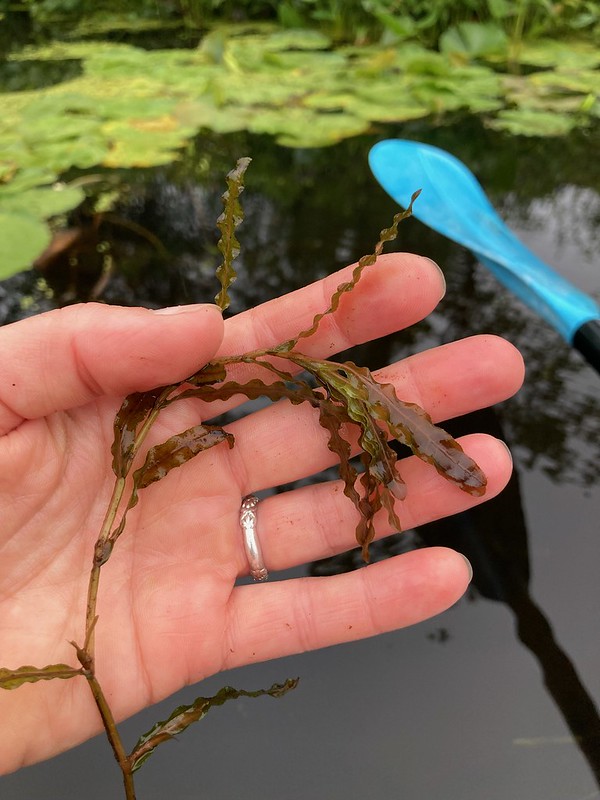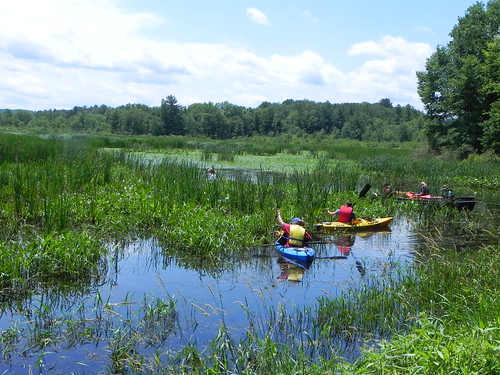I recently stayed at a friend’s cabin perched just above a small lake in an area that defines “the middle of nowhere”. Much of the weekend centered around water activities – swimming, kayaking, fishing, and more. And much of the weekend conversation centered around the plants in the lake. Because, to access the open water, one first had to navigate through thick mats of long-stemmed aquatic plants.
I was curious about what plants were actually there. What were their names? How did they survive? Were they invasive, introduced to this habitat intentionally or unintentionally and then multiplied? Because I had the time and the motivation, I laid belly-down on the dock and pulled out the long strings of leaves, stems, and flowers and tried to identify them. The only identification book available was one created by an herbicide company. There was more content about the effectiveness of different chemicals than the specific traits of the plant species, but it gave me enough to at least get started.

Starting this identification work, my brain felt stiff, like muscles that haven’t been exercised in a while. I love plants but don’t know a lot about those that live solely in the water. I thought of my grandma. She taught me to swim and not be afraid of the water. And, even as her body deteriorated with illness and age, people would always comment on the sharpness of her brain and her thirst to continue to learn. I make a note to myself to do this “brain work” more often and continued sorting through sepals, leaf structure, and textures.
After a short time, I got excited. These plants have some fascinating features to survive and thrive in their habitat. The most abundant plant I identified as Water Shield. The lily pad leaves are a few inches across. They float on the surface of the water and are attached to the bottom with long, red stems. And all parts of the plant emerging from underwater, including leaves, stems, and flower buds are covered in a thick, gelatinous slime. I thought perhaps it helped the plant float but I read later that the slime prevents it from drying out and may prevent animals from eating it.
Some of the Water Shield plants were starting to bloom. Small, reddish-purple flowers floated among the leaves. While the flowers are not remarkable, their biology is. Each flower only blooms for two days. But to ensure cross-pollination, it changes dramatically each day. On the first day, the pistil of the flower emerges. This is the female part of the flower that, when fertilized by pollen, makes the seed. After a full day in bloom, the flower dips down below the water’s surface at night. On the second day it emerges with stamens, which are the male part of the flower that holds the pollen. So the first day the flower is female. The second day it is male. It changes in between so it doesn’t pollinate itself but spreads it’s pollen to another flower.

Another plant that kept catching my eye was a bladderwort. I couldn’t identify the specific species, but the plant floating just under the surface had the characteristic sacks, also called bladders, among the delicate leaves. There are 220 species of bladderwort in the genus Utricularia and all are carnivorous. I’ve seen similar plants and just assumed the hollow bladders helped them float, while the flowers did the eating, similar to my Venus Flytrap I had when I was younger. But further research proved me wrong. I read later that when a small animal moves close to one of the bladders, it triggers the small hairs on the plant. The bladder opens and the animal is sucked into the bladder. The bladder closes and the animal is digested, providing nutrients to the plant.
One thing I noticed as I learned more about aquatic plants was that many of them are called “weeds.” There are numerous pondweeds, a Marshweed, and a Pickerelweed. I think this speaks to our relationship with these plants. At the cabin, much of the conversation was about how to remove these plants to better access the water. Would hand pulling, raking, muck mats, or herbicide be the best option?
So much of being in nature is figuring out the balance between us and the plants, animals, and non-living materials that make up the world. How can we do the best for nature while also doing what we need and want?
I find this struggle for balance is highlighted in aquatic plants. At Audubon, we pull invasive Water Chestnut from our ponds to prevent it from taking over and crowding out other native plants. The harvesters are continuously running on Chautauqua Lake and Cassadaga Lake to mow down the plants and make access easier for humans. And the conversation about a longer term solutions about “the weeds” is still happening for these and so many other bodies of water we live near and play in.
Regardless of where you fall on the spectrum on nature’s needs versus human needs and desires, the starting point can always be knowledge. So harness your inner “nature nerd”, lay down on the dock, in the grass, or just look out the window, and be curious. Ask. Research. Learn. Wonder. And let nature be your teacher.
Katie Finch is a naturalist at Audubon.
Audubon Community Nature Center builds and nurtures connections between people and nature. ACNC is located just east of Route 62 between Warren and Jamestown. The trails are open from dawn to dusk as is Liberty, the Bald Eagle. The Nature Center is open from 10 a.m. until 4:30 p.m. daily except Sunday when it opens at 1 p.m. More information can be found online at auduboncnc.org or by calling (716) 569-2345.


Recent Comments